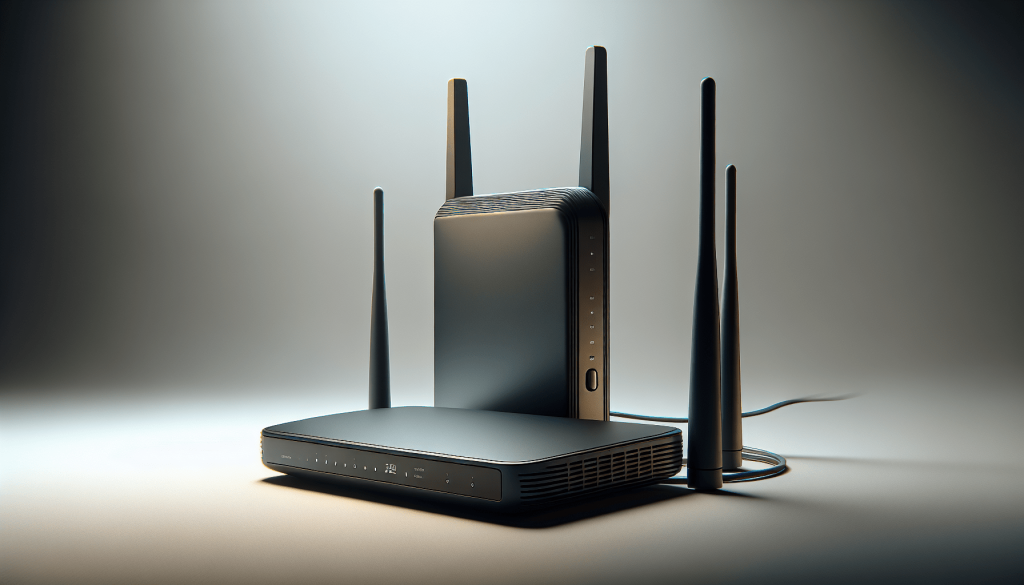In the world of Internet and connectivity, it’s important to understand the distinction between a modem and a router. While these two devices work together to bring the interwebs into your home or office, they serve different functions. A modem is the critical link between your network and the Internet, converting the digital signals from your provider into a format your devices can understand. On the other hand, a router acts as a traffic director, allowing multiple devices to connect to the modem and share the Internet connection. So, whether you’re a tech guru or simply curious about the inner workings of your home network, let’s explore the differences between a modem and a router.

Definition of Modem
Explanation of a modem
A modem, short for “modulator-demodulator,” is a device that enables communication between your home network and your internet service provider (ISP). It serves as a bridge between the digital signals used by your devices and the analog signals used by your ISP. The modem converts the digital data from your devices into analog signals that can be transmitted over telephone lines, coaxial cables, or fiber optic cables. Likewise, it also converts the analog signals from your ISP back into digital data that your devices can understand.
Functions of a modem
The primary function of a modem is to establish a connection between your home network and your ISP, allowing you to access the internet. It enables the transmission of data between your devices, such as computers, smartphones, or smart TVs, and the internet. Additionally, modems often include features such as data encryption and error correction to ensure reliable and secure data transmission. Some advanced modems also have multiple Ethernet ports or Wi-Fi capabilities to directly connect devices or create a wireless network.
Types of modems
There are several types of modems available, each suited for different types of internet connections. The most common types include:
- DSL Modems: These modems use your existing telephone line to provide an internet connection. They are typically used for ADSL (Asymmetric Digital Subscriber Line) connections, which offer faster download speeds compared to upload speeds.
- Cable Modems: Cable modems connect to your cable TV provider’s infrastructure to deliver internet connectivity. They offer higher speeds than DSL modems and are commonly used for cable internet connections.
- Fiber Optic Modems: These modems utilize fiber optic cables to transmit data at incredibly high speeds. Fiber technology is known for its reliability and fast internet speeds.
- Satellite Modems: In areas without traditional wired connections, satellite modems can be used to establish an internet connection by transmitting data to and from satellites.
Definition of Router
Explanation of a router
A router is a device that connects multiple devices within your home network and directs network traffic between them. It acts as a central hub, enabling communication between devices, such as computers, smartphones, printers, and smart home devices. Unlike a modem, a router does not directly connect to the internet but instead manages the flow of data within your local network.
Functions of a router
The main function of a router is to forward data packets between devices within a network. It examines the destination IP addresses of incoming data packets and determines the most efficient path for the packets to reach their intended recipients. Additionally, routers often provide network address translation (NAT), which allows multiple devices within your network to share a single internet IP address. Routers also offer features such as firewall protection, port forwarding, and quality of service (QoS) settings to enhance network security and prioritize certain types of network traffic.
Types of routers
Various types of routers are available, catering to different networking needs. Some common types include:
- Wireless Routers: These routers incorporate Wi-Fi capabilities, allowing wireless devices to connect to the network. They typically have multiple antennas to provide wider coverage and support for multiple wireless standards, such as 802.11ac or 802.11ax.
- Wired Routers: Wired routers primarily focus on providing connectivity through Ethernet ports. They are often used in situations where a stable and high-speed wired connection is essential, such as for gaming consoles or stationary desktop computers.
- Dual-Band/Multi-Band Routers: These routers offer support for multiple wireless frequencies, such as 2.4 GHz and 5 GHz. They provide flexibility in choosing the best frequency for your devices, reducing interference and improving overall network performance.
- Mesh Routers: Mesh routers consist of multiple devices that work together to create a seamless Wi-Fi network with extended coverage. They are ideal for large homes or offices with dead spots, ensuring a strong and reliable signal throughout the entire space.
Basic Functionality
How modems work
A modem receives the data signal from your ISP, which is usually transmitted over telephone lines, cable lines, or fiber optic cables. It then converts that analog signal into digital data that your devices can understand. When you send data from your device, the modem performs the reverse process, converting the digital data into an analog signal that can be transmitted back to the ISP. This bidirectional conversion allows for two-way communication, enabling you to browse the internet, stream videos, make video calls, and engage in various other online activities.
How routers work
Routers receive the digital data packets from devices connected to your home network and analyze the destination IP addresses within those packets. They use this information to determine the most efficient path for the data to reach its intended destination. Routers maintain a routing table, which stores information about the available routes and the associated IP addresses. They use this table to forward the data packets to the appropriate devices within the local network or to devices outside the network, such as servers or other networks connected to the internet.
Understanding data transmission
Data transmission is the process of sending and receiving information between devices. When you request a webpage or send an email, the data is broken down into packets by your device. These packets contain the data along with the source and destination IP addresses. The packets are then transmitted over the internet, hopping through various routers along the way. Each router examines the destination IP address and determines the next hop for the packets. The packets eventually reach the destination device, where they are reassembled to recreate the original data.
Internet Connection
Modem as the gateway to the internet
The modem plays a vital role in connecting your home network to the internet. It establishes the physical connection between your ISP and your network, allowing you to access the vast resources available on the world wide web. The modem facilitates the transmission of data packets between your devices and the internet, effectively acting as the gateway for all incoming and outgoing traffic. Without a functioning modem, your devices would not be able to establish an internet connection.
Router’s role in connecting devices to the internet
While the modem connects your network to the internet, the router enables multiple devices within your network to access and utilize that internet connection. By connecting your devices to the router via wired or wireless connections, the router manages the distribution of internet bandwidth among those devices. It also provides network services, such as IP address assignment and network security, ensuring that your devices can safely and efficiently connect to the internet.

Hardware Distinction
Physical appearance of modems
Modems typically come in small, compact boxes that are designed to be placed near the point of entry for your internet connection. They may have blinking lights indicating the status of the connection and the presence of any errors. Modems may have various ports for connecting cables, such as Ethernet ports for wired connections or coaxial ports for cable internet connections. Some modems also incorporate Wi-Fi capabilities, visible through the presence of antennas or the inclusion of a wireless network name and password.
Physical appearance of routers
Routers vary in size and design but are generally larger and more visible compared to modems. They often have multiple antennas protruding from the body or sleek, modern designs. Routers may feature indicator lights to display the status of the network and the connections to devices. They typically have several Ethernet ports for wired connections, along with a power port and sometimes a WAN (Wide Area Network) port for connecting to the modem. Additionally, routers with Wi-Fi capabilities will have visible antennas or built-in internal antennas.
Ports and connections on each device
Modems and routers have different ports and connections to fulfill their respective roles. Modems usually have a port to connect to the internet service provider’s network infrastructure, such as a telephone line or a cable connector. They also have one or more Ethernet ports for wired device connections, allowing you to directly connect a computer or a router. If the modem includes Wi-Fi functionality, it will have a wireless antenna or a built-in wireless access point to provide wireless connectivity to devices.
Routers, on the other hand, have a port specifically dedicated to connecting to the modem, often labeled as the WAN port. This port receives the internet connection from the modem and distributes it to the other devices within your network. Routers also have several Ethernet ports, typically labeled as LAN ports, for connecting devices via wired connections. Additionally, routers with Wi-Fi capabilities have antennas or built-in wireless access points to provide wireless connectivity options.
Configurations and Settings
Modem configuration and setup
When setting up a modem, you typically need to follow the instructions provided by your ISP or the modem manufacturer. This may involve connecting the modem to the appropriate cables or ports, such as the telephone line or the cable connector. Once physically connected, you may need to access the modem’s configuration page through a web browser to enter the necessary credentials, such as your ISP-provided username and password. The configuration page also allows you to adjust various settings, including security features, network name (SSID), or IP addressing options.
Router configuration and setup
Setting up a router involves connecting it to the modem via the WAN port and then connecting your devices to the router, either through wired Ethernet connections or wirelessly through the Wi-Fi network. Most routers have a web-based interface that you can access through a web browser to configure the router’s settings. This interface allows you to set up a secure Wi-Fi password, customize the network name (SSID), and configure other features like firewall settings and parental controls. Some routers also provide mobile apps for easier configuration and management.
Differences in settings and options
While both modems and routers have configuration settings, the options available may differ. Modems primarily focus on establishing the internet connection, so their settings revolve around aspects like the connection type (DSL, cable, etc.), transmission standards, and compatibility with your ISP. Routers offer more extensive configuration options, including network security settings, quality of service (QoS) settings to prioritize certain devices or applications, port forwarding options, and VPN (Virtual Private Network) configuration. The broader range of settings in routers reflects their role as the central hub for managing your home network.
Network Management
Modem’s role in network management
In terms of network management, modems are more focused on establishing and maintaining an internet connection rather than managing the devices within your local network. However, some advanced modems may provide basic features for managing network settings, such as controlling the IP addresses assigned to devices or managing user access through a built-in firewall. Overall, the primary function of a modem is to enable connectivity to the internet, while network management tasks are usually handled by the router.
Router’s role in network management
Routers play a crucial role in managing your home network. They control the flow of data packets between devices, assign IP addresses to devices connected to the network, and ensure the seamless operation of various network services. Routers often provide advanced network management features, such as bandwidth allocation, content filtering, and device prioritization. Additionally, some routers offer remote management capabilities, allowing you to access and configure the router’s settings from anywhere via the internet.
Administering and controlling network settings
To administer and control network settings, routers offer a web-based interface or mobile apps that allow you to access and configure various aspects of your network. This includes managing IP addresses, setting up port forwarding for specific applications or services, creating guest networks for visitors, and implementing parental controls to limit access for certain devices or users. Network settings can be adjusted according to your requirements, ensuring optimal network performance, security, and user experience.
Usage Scenarios
When to use a modem
A modem is essential for establishing an internet connection. If you are subscribing to an internet service provided by your ISP, you will need a modem compatible with the service’s specifications. Modems are primarily used in scenarios where you want to connect a single device directly to the internet, such as when using a desktop computer or a specific device requiring a wired connection. They are suitable for environments where basic internet connectivity is the primary requirement without the need for extensive network management or device-to-device communication.
When to use a router
A router is necessary when multiple devices within a network need to connect to the internet or communicate with each other. If you have smartphones, laptops, smart TVs, gaming consoles, or smart home devices that require internet access, a router becomes crucial. Routers provide the flexibility of both wired and wireless connections, allowing multiple devices to connect simultaneously. They enable efficient distribution of bandwidth and offer essential network management features for optimal performance and security.
Combining modem and router functionalities
To fully utilize the benefits of both modems and routers, many people use a combination device called a “modem-router” or “gateway.” These devices integrate both modem and router functionalities into a single unit, eliminating the need for separate devices and often simplifying the setup process. Modem-routers are commonly provided by ISPs as part of their internet service packages. However, it is also possible to purchase standalone modems and routers separately and connect them to optimize network performance and customize your network setup according to your specific requirements.
Consumer Perspective
Considerations when purchasing a modem
When purchasing a modem, there are several factors to consider. Firstly, you need to ensure compatibility with your ISP. Different ISPs may have specific requirements for modems, including supported connection types and transmission standards. It is crucial to check with your ISP or consult their website to determine the compatible modem options. Secondly, consider the internet speeds offered by your ISP and choose a modem that supports those speeds. Lastly, evaluate any additional features you may require, such as Wi-Fi capabilities or multiple Ethernet ports, to ensure the modem meets your specific needs.
Considerations when purchasing a router
When selecting a router, the coverage area and number of devices you plan to connect are vital considerations. Determine the size of your home or office and choose a router with adequate coverage range, avoiding dead zones or areas with weak signals. Additionally, consider the number of devices that will be simultaneously connected to the network and ensure the router can handle the required bandwidth. Other factors to consider include the router’s wireless standard (e.g., 802.11ac, 802.11ax), number of Ethernet ports, and advanced features like parental controls or VPN support.
Compatibility with internet service providers
Both modems and routers must be compatible with your internet service provider to ensure proper functionality. ISPs often maintain lists of approved or recommended modem and router models that have been tested and certified for use on their networks. Before purchasing any device, it is important to consult your ISP’s website or contact their support to verify compatibility. Using devices endorsed by your ISP not only ensures compatibility but may also simplify setup and troubleshooting processes, as ISP support teams will be familiar with the approved hardware.
Conclusion
Summary of key differences
In summary, modems and routers serve distinct roles in establishing internet connectivity and managing home networks. A modem connects your network to your ISP, translating digital data into analog signals for transmission over telephone lines, cable lines, or fiber optic cables. Routers, on the other hand, direct network traffic between multiple devices within your home network, managing the flow of data packets and providing essential network services. While modems focus on internet connectivity, routers enable efficient device-to-device communication and offer advanced network management features.
Importance of understanding the distinction
Understanding the distinction between modems and routers is crucial for a smooth and efficient internet experience. By comprehending how each device works and their respective functions, you can make informed decisions when purchasing and setting up your network equipment. Choosing the right device for your needs ensures optimal connectivity, network performance, and security. Additionally, understanding the distinction empowers you to troubleshoot and resolve network issues, further enhancing your online experience.
Choosing the right device for your needs
When selecting a modem and router, consider your specific requirements, such as the type of internet connection, the size of your network, the devices being connected, and the desired network management features. Research various models, compare specifications and reviews, and consult with your ISP if necessary. By choosing the right devices and configuring them appropriately, you can create a robust and reliable home network that meets your internet connectivity needs while providing the necessary functionality for all your devices.
